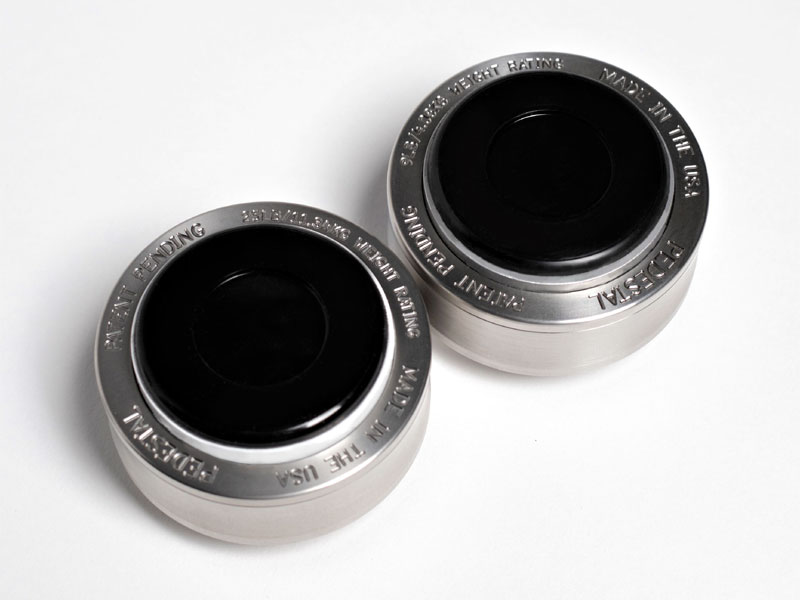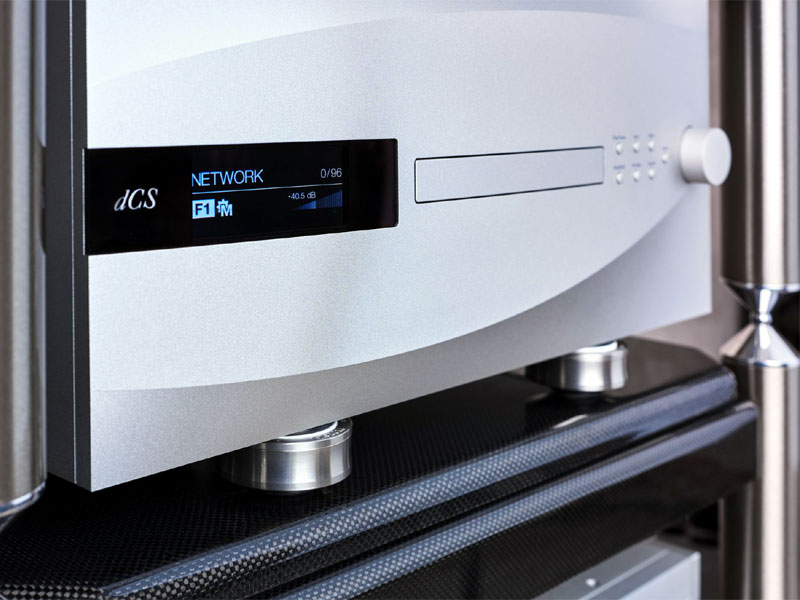First Sounds: Wilson Audio Pedestal
n quick reflection, Wilson Audio's Pedestal equipment supports ($2225 per set of three) seem out of place in the company's product lineup. Wilson is a speaker manufacturer, of course; so what exactly does the company know about equipment supports? The answer was hiding in plain sight: One of the core technologies of Wilson speakers, the use of advanced materials in specific ways to reduce unmusical resonance within speaker cabinets, dovetails nicely with the aim of a product like the Pedestal -- reducing all manner of vibration and resonance that negatively affect electronics and source components. The light-bulb moment for the Pedestal occurred as Daryl Wilson helped a friend set up his speakers. "As we executed the Wilson Audio Setup Procedure (WASP)," Daryl said, "I was silently working out ways to minimize vibrations traveling up into the turntable specifically." Blake Schmutz, Wilson's materials engineer, took the concept from there. The R&D that went into the ISOBase platform for Wilson's smallest speaker, the TuneTot, led to the realization that the company could use similar technology to significantly reduce, or eliminate, vibration in electronics. The goal was to isolate and then absorb vibrations that traveled into the components from the environment or were created by electronic gear itself, such as a digital disc player. "By leveraging the unique isolation characteristics of several materials in a single design," Schmutz said, "we were able to create a product that performs exceptionally well across the audio spectrum." Each Pedestal is highly refined. Daryl Wilson uses the phrase "nutrient dense" to describe it, the idea being that the Pedestal packs a great deal of R&D, materials science and manufacturing skill into a compact (2 1/4" diameter, 1 5/16" high) and light (8 ounces) package. The Pedestal is roughly shaped like a cone but with a broad, flat tip. The outer shell is non-magnetic stainless steel, which, according to Wilson, "exhibits superior vibration-mitigating characteristics and effectively eliminates undesirable electronic interactions with components caused by magnetizable steel." Inside is a sort of sandwich of Wilson's V-Material and proprietary viscous damping materials. The pad on the top of the Pedestal is softer, which gives it a stickiness that prevents the Pedestal from sliding around underneath the component. The bottom pad is denser and therefore has a more rubbery feel. It is adhered to the steel housing, while the top pad is adhered to the V-Material. In between the V-Material and the bottom of the housing is an elastomeric material, made to Wilson's requirements. This acts almost like a spring between the stainless-steel housing and the V-Material. When compressed, the Pedestal decouples the vibration absorption of the V-Material from the surrounding stainless-steel housing. While most similar products claim either coupling or isolation, the Pedestal does both, coupling effectively to the product it supports, providing an exit path for vibration, and isolating the component from external vibration that travels through the air or whatever the Pedestals are sitting on. There are two different versions of the Pedestal, White and Silver, used for products of different weights. You can tell them apart by engraving around the top ring or by the color of the sliver of V-Material that shows near the top: white for high density and silver for low density. Each high-density Pedestal can support 8-25 pounds, and each low-density 3-9 pounds. The idea is to use whichever model (or a combination of them; more on this below) to support and isolate the component, making sure that each Pedestal compresses, so what's inside decouples from the outer shell. The only significant difference between the White and Silver Pedestals is the elastomeric material between the stainless-steel housing and the V-Material. They are the same material, but they have different compression ratings. You can feel the difference when you press down -- the low-density version moves with very little force to compress the elastomeric material, while you'll have to lean on the high-density version to see the same amount of movement.
Like any such device, the Pedestal responds to careful installation, Initially, Wilson Audio sent me a set of three White Pedestals to try. I was so impressed that I asked for a fourth to use with a heavy amplifier, and then a set of three Silver Pedestals to use with a turntable. However, that second set arrived with two low-density and one high-density by mistake, which turned out to be fortuitous. I set about experimenting with mixing the two models and found that using them together, strategically, improved on the performance of a complete set of either weight. This makes sense if you consider that the distribution of weight for any piece of audio equipment is rarely uniform from front to back and side to side. This is often due to the placement of the transformer, which is heavy, but it can also be a matter of where a turntable's motor is located, or simply how circuit boards fit within a chassis. With the different Pedestals, I was able to account for these differences, placing a White directly underneath a transformer, for instance, and using Silvers in front, where the product is lightest. With a mix of Pedestals, you can experiment to your heart's content. One more tip I discovered has to do with the elastomeric material on top of each Pedestal. This is slightly tacky, allowing for very good contact with a component's flat bottom surface (if it is indeed flat). In order to take advantage of that slight stickiness, I used a lint roller or some painter's tape to remove all dust and fine debris from the top before putting the Pedestal underneath a component. This had the added benefit of also keeping the Pedestal in place if I picked up the component to readjust placement. I used the Pedestals under various components and on top of everything from pieces of Corian to ceramic tiles, with the most interesting combination being the IKEA Aptitlig bamboo chopping boards that Roy Gregory wrote about a few years ago or my homemade isolation platform that uses a pair of the boards along with some ball bearings. The differences heard with the Pedestals were dependent on the products they supported, but they were wholly positive, ranging from discernible to drop-dead obvious. Instrumental lines were better delineated, the treble and midrange were clearer, the bass firmer and more detailed -- everything was better, top to bottom. I surmise that the Pedestals let the equipment sound not just its best but exactly like what it's supposed to sound like without the blurring and general obfuscation of micro-vibration and resonance. This was especially true with analog -- both a turntable and phono stage. With less obscuring vibration, there was more music.
Wilson Audio is adamant about the Pedestal not being for use with speakers. With Wilson speakers, the extra height of the Pedestals would throw off the precise time alignment, not to mention that the speakers are so heavy that you'd have to use many of them underneath even the smaller models. However, I can foresee that the Pedestals might be highly effective with other speakers -- ones that are single boxes, with or without attached plinths -- especially if the floor of the listening area is springy or resonant. Just be sure to do the math and ensure that each speaker is not too heavy, or is heavy enough, for the Pedestals you have available to you. While the Pedestal isn't Wilson Audio's first non-speaker
product, it is a very serious and effective equipment support, and it uses more advanced
materials and well-thought-out technology than many competing products, including some
entire equipment racks. I keep finding new ways to use them -- in
number and placement; in fact, I'm not sure I've gotten even a small fraction of the
utility and performance out of them yet. Stayed tuned. |


